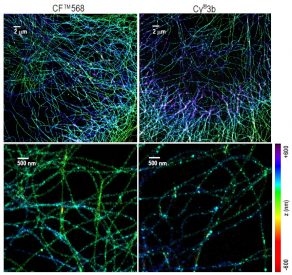Signaling from extracellular matrix and intercellular junctions to the cell nucleus through adhesion molecules has long been proposed as a mechanism of tissue morphogeneisis, differentiation, and tumor supression. Now, Jorgens and colleagues have utilized new advances in imaging of 3D cell cultures to reveal that cytoskeletal connections from basement membrane and adherens junctions extend far inside the nuclear envelope. In a recent publication in the Journal of Cell Science, they demonstrate actin filaments and intermediate filaments penetrate deep into the nucleus. By using Biotium’s CF™568 for two-color STORM super-resolution imaging, they showed that SUN domain proteins anchor cytoskeletal filmants inside deep tunnels within the nuclear envelope. These previously unobserved structures provide a direct link and possible mechanical signaling pathway between extracellular junctions and the nucleus.
To read the original article, click here.
Danielle M. Jorgens, Jamie L. Inman, Michal Wojcik, Claire Robertson, Hildur Palsdottir, Wen-Ting Tsai, Haina Huang, Alexandre Bruni-Cardoso, Claudia S. López, Mina J. Bissell, Ke Xu, Manfred Auer. Deep nuclear invaginations are linked to cytoskeletal filaments – integrated bioimaging of epithelial cells in 3D culture. J Cell Sci 2017 130: 177-189; doi: 10.1242/jcs.190967

To learn more about CF™ dyes for Super Resolution microscopy, click here.

